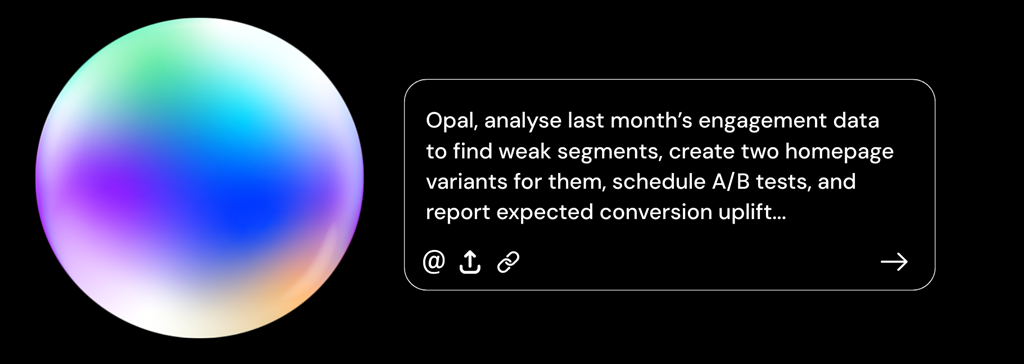Optimizely Opal – the agentic orchestration platform
Justin Masters

At Opticon 2025, Optimizely showcased how Opal AI is evolving into a market-leading platform for agent orchestration, powered by customisable workflows. With the flexibility to design workflows of interconnected AI agents, the release of a suite of out-of-the-box agents, and the opportunity for partners like Netcel to create specialised agents tailored to specific use cases, Optimizely has firmly positioned itself as an AI-native Digital Experience Platform (DXP).
AI isn’t magic. However, it can feel like it when it eliminates repetitive tasks, uncovers insights you never had time to explore, and orchestrates complex workflows. At Netcel, we see orchestration as the bridge between AI hype and real business value.
Over the past year, Opal has evolved from a productivity-focused AI assistant into a fully-fledged agentic orchestration platform. This shift reduces reliance on disparate, siloed AI tools by enabling companies to unify agents across systems. Opal can seamlessly integrate external agents - such as Microsoft Copilot - into orchestrated workflows, while reserving Optimizely’s own embedded agents for tasks enriched by its native data and capabilities. This flexible model ensures organisations can optimise both performance and cost, using the right AI in the right place while maintaining control over AI consumption.
This is significant for digital leaders - the move from individual AI use cases to orchestrated, multi-agent systems that can autonomously act, adapt, and scale. For organisations already invested in Optimizely, the opportunity is clear: unlock new ways of working, accelerate innovation and customer experience strategies.
From assistant to orchestrator
When Optimizely first launched Opal, its purpose was to accelerate tasks like content creation and insights through AI assistance. Today, it has matured into an AI-native agentic platform, embedded within workflows, enriched with your data, and capable of coordinating agents that communicate and integrate seamlessly across business processes. By drawing on the full Optimizely ecosystem - customer data, analytics, brand guidelines, and tone of voice - you can now create more intelligent, context-aware agents that deliver stronger outcomes.
Why it matters
Agentic AI isn’t just a buzzword - it’s a new operating model. Instead of asking AI to generate content and campaigns in one platform and analyse performance in another, teams of agents can work together, for example:
- Generate content aligned with brand guidelines.
- Test and optimise variations in real time.
- Analyse performance and feed insights back into the system.
This closed-loop orchestration can deliver scale and speed that human-only workflows can’t match.
For digital leaders, this brings both opportunity and challenge:
- Opportunity: Faster time to market, adaptive experiences, and data-driven optimisation at scale.
- Challenge: Governance, ethics, and ensuring agentic AI augments rather than undermines human creativity and strategic direction.
Understanding the impact
At Netcel, we believe the most important first step is not adopting agents blindly but understanding where agentic AI can create the most impact - and where caution is needed.
That’s why we’ve created the Opal AI Impact Audit: a practical assessment that helps organisations explore where agentic AI can deliver value across digital operations.
The audit focuses on three areas:
- Opportunity Mapping – Identifying high-impact use cases across your Optimizely environment.
- Risk Assessment – Addressing governance, compliance, and brand control considerations.
- Readiness Planning – Outlining the roadmap for safely and effectively orchestrating AI agents within your digital strategy.
Learn more about the Opal AI Impact Audit.
We see this shift as more than a technology upgrade - it’s a redefined operating model. Organisations that succeed with agentic AI will be those that balance innovation with responsibility. Agentic AI isn’t about replacing people; it’s about amplifying them. The real value comes when human creativity and oversight are combined with the scale and speed of orchestrated AI agents.
For example, a retailer could orchestrate content creation, testing, and optimisation in days rather than weeks - freeing teams to focus on creativity and strategy.
Looking ahead
The evolution of Opal into an agentic orchestration platform signals a fundamental shift in how digital platforms will operate. This isn’t just about faster workflows - it’s about redefining how digital experience management operates.
Businesses that take early, strategic steps now will be best positioned to harness the full potential of AI agents in the years ahead. The key is starting with clarity, governance, and impact in mind.
Register your interest in an Opal AI Impact Audit.